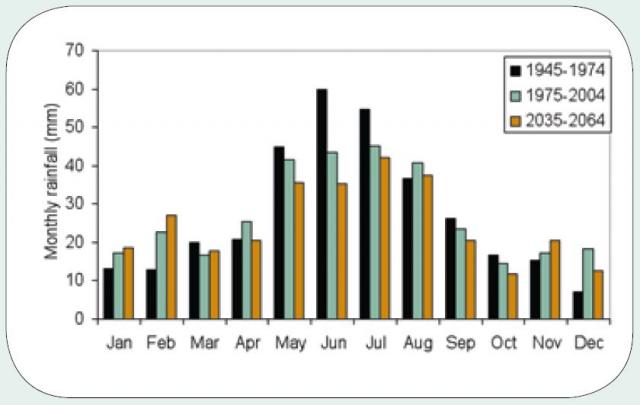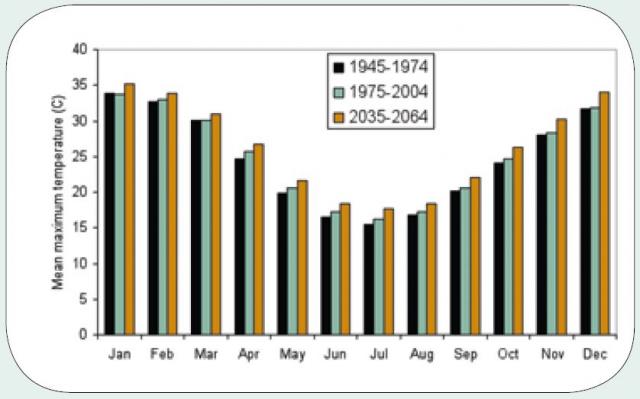Why this information is important
Climate change and climate variability have already affected Western Australian (WA) broadacre crop and animal production over recent decades, with significant reductions in rainfall and increased frost risk. Producers have been able to meet these challenges by adopting innovative farming systems to maintain farm profitability and sustainability. Future climate change will present further opportunities and challenges for producers.
Records shows that rainfall decreased and temperatures increased over the last century. Climate projections for the south-west of WA are for declining rainfall and higher temperatures.
The grainbelt of WA contributes more than $4.5 billion to WA’s economy each year. Merredin is 260 kilometres east of Perth, on the eastern edge of the central grainbelt. This agri-climate profile provides a historical analysis and future projections for a range of climate variables relevant to farm businesses in the Merredin area.
Changes at a glance
Around the mid-1970s, there was a shift to drier winter conditions in south-west WA.
The observed trends in Merredin’s climate include:
- little change in total annual rainfall
- a decline in growing season rainfall (April–October)
- an increase in summer rainfall
- fewer very wet years
- lighter and less frequent winter rainfalls
- a more variable and later start to the growing season
- an increase in average minimum and maximum temperatures
- a decline in the number of frost events in spring
- an increase in the number of very hot days in summer.
What the records show
There were shifts in climate for Merredin in the mid-1970s, then again around 2000. Therefore, the analysis for the periods from 1931–1974 (43 years), 1975–2018 (43 years) and 2000-2018 (18 years).
Rainfall
There has been little change in total annual rainfall. However, the growing season rainfall has declined by about 10% since the mid-1970s (Figure 1).
Around the mid-1970s, there was a shift to consistently drier winter conditions. Figure 2 shows the decline in early winter (May to July) and the increase in summer (December to February) rainfall from the period 1931–1974 to 1975–2018.
Figures 3 and 4 show that the reduction in winter rainfall is caused by a combination of less days with heavy rainfall events, and fewer rain days . The increase in summer rainfall has mainly resulted from heavier rainfall events in the period from December to February.
Temperature
Since the mid-1970s, mean monthly maximum temperatures significantly increased in the period April to July, and remained unchanged for the rest of the year (Figure 5). Mean monthly minimum temperatures significantly increased in all months except June and July (Figure 6).
The number of days with maximum temperature above 35 degrees Celsius (˚C) increased slightly in December (Figure 7). The number of frost day (days with minimum temperature below 2˚C) in August increased since 2000 (Figure 8).
Projected changes
Projections for the period 2035–2064 were obtained using an intermediate emissions scenario (A2) and downscaled data from the CSIRO Global Climate Model CCAM (CMIP3).
Rainfall
Projections are for less rainfall in autumn–winter and increased rainfall in summer (Figure 9).

Temperature
Projections are for increased mean maximum temperatures (Figure 10).

What are the agronomic implications?
- Declining autumn-winter rainfall has led to a more variable and generally later start to the growing season (Figure 11). The average start to the growing season, derived from a sowing window starting on 25 April, has shifted from 23 May for the period 1931–1974 to 26 May for 1975–2018 and to 28 May for 2000–2018.
- A later and more variable start to the growing season will increase production risk for crops and pastures. Declining autumn rainfall means crops need to be established at the earliest opportunity, possibly by dry sowing. Storage and conservation of out-of-season rain is gaining importance. Effective control of summer weeds and stubble is becoming more important. Deferred grazing of pastures at the break of season is likely to be more important.
- The reduction in heavy rainfalls in winter has led to a large reduction in reliability of run-off into farm dams. Roaded and natural catchments will need to be 15–20% larger to fill existing dams.
- Although there has been little change in total annual rainfall, the decline in average size of rainfalls has led to evaporation losses being more important and less water stored deep in the soil. This increases the risk of moisture stress during establishment, flowering and grain fill.
- Even though frost risk has decreased, it still remains a significant risk in winter and spring.
What are the options for adapting to climate change?
We provide information and technical support for making changes at the incremental, transitional and transformative levels. A general guide is available for each major enterprise and for soil and water resources:


